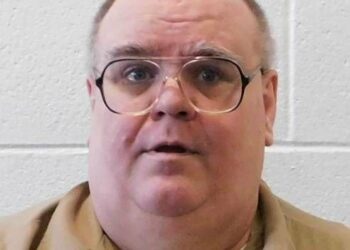Note: Former President Donald J. Trump is expected to attend this Saturday’s game between the second-ranked Georgia Bulldogs and the fourth-ranked Alabama Crimson Tide at Saban Field at Bryant-Denny Stadium in Tuscaloosa.
It will be Trump’s third time to watch the Tide, having attended the Jan. 8, 2018, national championship game between the Tide and Bulldogs in Atlanta and the Alabama-LSU game on Nov. 9, 2019, in Tuscaloosa — both times when he was the sitting president.
More than 60 years ago, though, another U.S. president became the first commander-in-chief to see the Crimson Tide play in person. This is the story of that day.
The date was Jan. 1, 1963, a steamy New Year’s Day afternoon in sunny South Florida.
The scene was Miami’s iconic Orange Bowl Stadium, where Paul “Bear” Bryant’s fifth-ranked Alabama Crimson Tide and Bud Wilkinson’s seventh-ranked Oklahoma Sooners squared off in the first meeting between two of college football’s most storied programs.
“You had Alabama and Oklahoma,” author and sports historian Allen Barra recalls. “You had Bear Bryant and Bud Wilkinson — Bear and Bud. It was going to be a big game anyway. . . .
“And then, bingo, JFK shows up.”
Ten minutes before kickoff, a helicopter carrying the 35th president of the United States, John F. Kennedy, flew into the packed Orange Bowl Stadium, where a banner announcing “Miami Welcomes President Kennedy” hung from the stadium’s upper deck.
Kennedy, an avid sports fan, watched the game from a lower-level box seat, where, according to The Birmingham News, he sat alongside his brothers-in-law, actor Peter Lawford and Peace Corps director Sargent Shriver, as well as Florida Gov. C. Farris Bryant.
Except for the box seats and the entourage accompanying him, Kennedy was just another face — albeit the most famous face — in a crowd of 73,379 fans.
“It’s incredible when you think about it,” Jay Rao, a Miami history buff and founder of the Facebook page The Ghosts of the Orange Bowl, says. “By today’s standards, no way would a president ever sit there.
“I know he had his security around him, but I was always amazed by how accessible Kennedy was.”
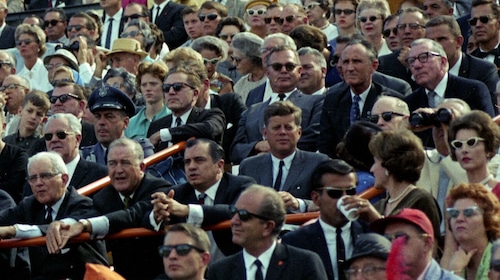
Surrounded by Secret Service agents, John F. Kennedy was the most famous face in a crowd of 73,379 fans at the 1963 Orange Bowl in Miami. (Photo courtesy of JFK Library)(Photo courtesy of JFK Library)
A first for the Tide
Kennedy, Rao adds, was no stranger to Miami or the Orange Bowl.
Two years before, he attended the 1961 Orange Bowl, when as president-elect, he watched Missouri beat Navy.
And on Dec. 29, 1962, just three days before the 1963 Orange Bowl, Kennedy appeared at the historic stadium for a ceremony honoring the surviving members of the Cuban brigade that led the failed Bay of Pigs invasion.
But, while it was nothing new for Kennedy, that ‘63 Orange Bowl was a first for the Crimson Tide.
In the university’s celebrated football history, previous Alabama teams had won Rose Bowls and captured national championships – including one just the season before, in 1961 — but this was the first time a sitting U.S. president would watch the Tide play in person.
Bryant, ever the field general, made sure his troops did not disappoint the commander-in-chief.
“He kept motivating us . . . as he did every game,” remembers Jim Simmons, a three-year letterman at Alabama who was a sophomore defensive tackle that season. “We didn’t want to show our backside playing in a game like this in front of the boss of the United States.”
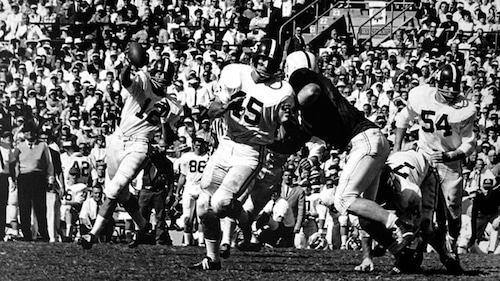
Alabama quarterback Joe Namath (12) throws a pass as Cotton Clark (45) tries to get open during the 1963 Orange Bowl. Namath passed for a touchdown and Clark ran for another in the Crimson Tide’s 17-0 shutout of the Oklahoma Sooners. (Photo courtesy of the Paul W. Bryant Museum)(Photo courtesy of the Paul W. Bryant Museum)
A not-unnoticed slight
The president, though, wasn’t at the Orange Bowl to cheer on the Tide as much as he was there to show his support for his friend Wilkinson.
The two developed a relationship after Kennedy appointed the Oklahoma coach — who led the Sooners to three national titles during a historic run in the 1950s — to chair the President’s Council on Physical Fitness soon after his inauguration in 1961.
Before he settled into his 50-yard-line seat on the Sooners’ side of the field, Kennedy stopped by the Oklahoma locker room to wish Wilkinson and his players well.
It was, Barra says, the Democrat Kennedy’s symbolic way of reaching across the aisle to the Republican Wilkinson, who would retire from coaching the following season and lose a tight race as Oklahoma’s Republican nominee in a 1964 special election for a seat in the U.S. Senate.
“It was really good for both publicity-wise – for JFK because Wilkinson was a Republican,” Barra, author of the Bryant biography “The Last Coach,” says. “Here he’s asking (Wilkinson’s) advice on stuff: ‘Coach, what do you think about our physical fitness program?’ It was a coup for Kennedy, no matter how you looked at it.”
Kennedy did not, however, extend the same hospitality toward Alabama before the game, and his slight — intended or not — did not go unnoticed by Bryant or his players.
“I just don’t think that he thought it through, that it was going to look the way it did,” Barra says of Kennedy’s apparent show of favoritism. “The very fact that he didn’t see that it would be perceived as a slight was kind of a slight in itself.”
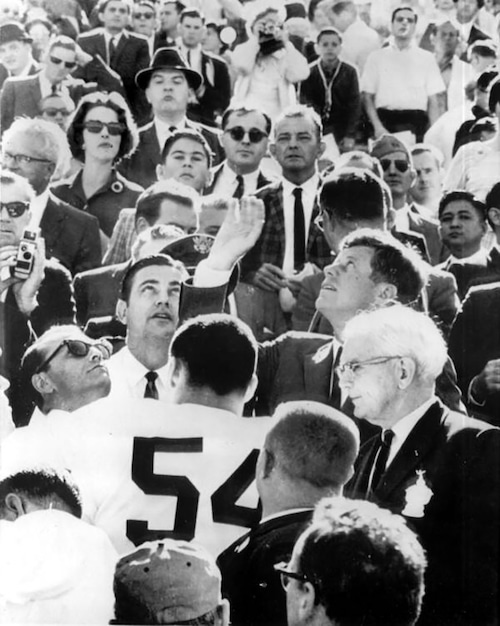
President John F. Kennedy performs the ceremonial coin toss prior to the 1963 Orange Bowl as Alabama’s Lee Roy Jordan (54) looks on. (Photo courtesy of the Paul W. Bryant Museum)
A keepsake coin
Before the kickoff, Kennedy participated in the ceremonial pre-game coin toss, which, for security reasons, was held in the president’s box seats, where he was surrounded by Secret Service agents, instead of at midfield.
Lee Roy Jordan, the Alabama captain, called tails, and not only did the Tide win the toss, but Jordan, a senior playing in his final game at Alabama, also got to take home the ceremonial coin as a souvenir.
“I kept that coin for forever,” Jordan told AL.com’s Creg Stephenson in 2018. “That’s the last thing I’ll discard before I go meet the maker.”
After losing the coin toss, it was all downhill for Oklahoma.
Spurred on by sensational sophomore quarterback Joe Namath — who, six years later, would lead the New York Jets to one of the most monumental upsets in Super Bowl history in that same stadium — the Tide jumped out to a 14-0 halftime lead and never looked back.
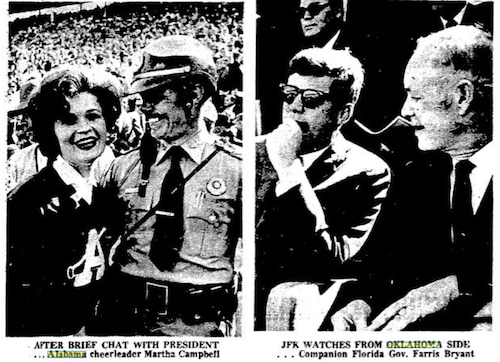
The Jan. 2, 1963, editions of The Birmingham News featured these photos of Alabama cheerleader Martha Campbell, in the left photo, and President John F. Kenndy, sitting with Florida Gov. C.. Farris Bryant in the right photo. Campbell got to meet the president at halftime of the 1963 Orange Bowl between Alabama and Oklahoma. (Photos by Robert Adams from The Birmingham News archives)(Photos by Robert Adams from The Birmingham News archives)
A halftime visit
At halftime, Kennedy — perhaps to make amends for disrespecting Alabama before the game or maybe as a show of appreciation for the Tide’s commanding performance — invited 19-year-old UA cheerleader Martha Campbell to visit him in his box seats.
Campbell, who was escorted by a police officer, was more than a little awestruck at meeting the president and burst into tears.
“Hello,” Kennedy told her, according to a story in the next day’s Miami Herald. “Your team is doing mighty well, isn’t it?”
Campbell, a speech major from Scottsboro, was at a loss for words.
“I couldn’t even remember my name,” she said.
After play resumed, Alabama kicker Tim Davis tacked on a 19-yard field goal in the third quarter, and the Tide rolled to a 17-0 shutout of the Sooners.
Jordan, the ferocious senior linebacker who got to keep the coin that Kennedy flipped before the game, capped off a storybook day – and his Alabama career — by totaling an astounding 31 tackles, which remains a school record.
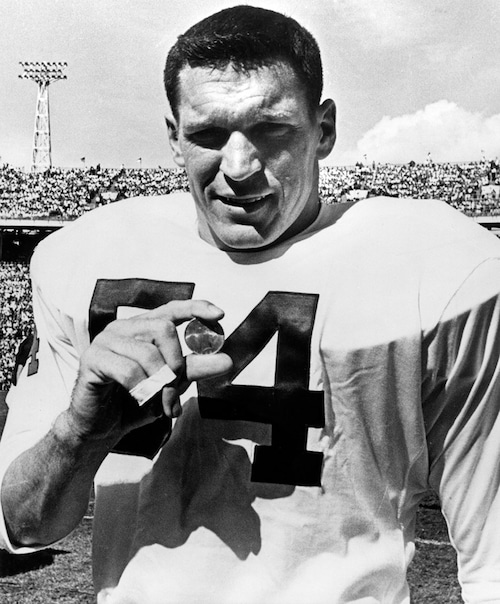
Alabama captain Lee Roy Jordan, who capped off his Crimson Tide career with a school-record 31 tackles in his final game at UA, shows off the ceremonial coin flipped by President John F. Kennedy before the 1963 Orange Bowl. (Photo courtesy of the Paul W. Bryant Museum)
A wonderful memory
In his post-game press conference, someone joked with Bryant that Kennedy had just made a special announcement, selecting the Alabama coach to replace Wilkinson as his chairman of the President’s Council on Physical Fitness.
Bryant, who greatly admired the Oklahoma coach, just grinned.
“The president of the United States couldn’t have been but amazed yesterday as he sat in a humid Orange Bowl with some 73,000 others and witnessed the superb fitness of Bryant’s boys from Alabama,” columnist Alf Van Hoose opined in the next day’s Birmingham News.
“Bud Wilkinson’s troops, commanded by a man dedicated to replacing muscle for fat in American youth, were sharply honed for battle, too, but Alabama’s men were fitter.”
The front page of that day’s edition of The News featured three thumbnail photos of Kennedy at the game underneath the headline “Wilkinson walks into another ‘Bear’ trap” and the subhead “As Kennedy saw Tide sink Sooners.”
Sadly, it would be Kennedy’s first and last time to see the Tide.
Eleven months later, on Nov. 22, 1963, JFK wasassassinated as he rode in a motorcade through Dealey Plaza in downtown Dallas.
For Simmons, the former Alabama defensive lineman, getting to play on a national stage in front of the president of the United States was beyond anything a kid from the small town of Piedmont could have ever dreamed.
“It was a wonderful memory,” Simmons, now in his early 80s, says. “I wouldn’t know if I was a Democrat or a Republican at that time, but just knowing that the main man was in the stands . . . it was quite a show.”
Acknowledgments: In addition to original interviews, this story is based on reports from The Birmingham News, AL.com and Miami Herald archives, as well as excerpts from the books “The Last Coach” by Allen Barra and “Bowl Bama Bowl” by Al Browning. Photos are courtesy of the Paul W. Bryant Museum and the JFK Library, along with photos from The Birmingham News archives.
Source link : http://www.bing.com/news/apiclick.aspx?ref=FexRss&aid=&tid=66f59c2eeabc4a08a88a9c057f8ba136&url=https%3A%2F%2Fwww.al.com%2Falabamafootball%2F2024%2F09%2Fthe-first-time-a-us-president-watched-the-alabama-crimson-tide-roll.html&c=14781037756369422777&mkt=en-us
Author :
Publish date : 2024-09-26 05:55:00
Copyright for syndicated content belongs to the linked Source.


